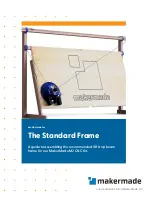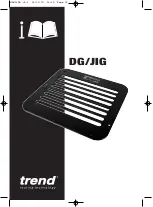
The noise level when working can exceed the
volume stated.
Wear hearing protection!
Vibration total values a
h
(triax vector sum) and un-
certainty K determined according
to
EN 62841-2-14
a
h
<2.5
m/s
2
, K =
1.5
m/s
2
.
The vibration level and noise emission value given
in these instructions have been measured in ac-
cordance with a standardised measuring proced-
ure and may be used to compare power tools.
They may also be used for a preliminary estima-
tion of vibration and noise emissions.
The stated vibration level and noise emission
value represent the main applications of the
power tool. However, if the power tool is used for
other applications, with different application tools
or is poorly maintained, the vibration level and
noise emission value may differ. This may signific-
antly increase the vibration and noise emissions
over the total working period.
To estimate vibration and noise emissions accur-
ately, the times when the tool is switched off or
when it is running but not actually being used
should also be taken into account. This may signi-
ficantly reduce vibration and noise emissions over
the total working period.
Implement additional safety measures to protect
the operator from the effects of vibration, such as
servicing the power tool and application tools,
keeping their hands warm, and organising work-
flows correctly.
Fitting
English
u
Remove the battery from the power tool be-
fore carrying out work on the power tool (e.g.
maintenance, changing tool, etc.). The bat-
tery should also be removed for transport and
storage.
There is risk of injury from unintention-
ally pressing the on/off switch.
Battery Charging
English
u
Use only the chargers listed in the technical
data.
Only these chargers are matched to the
lithium-ion battery of your power tool.
Note:
The battery is supplied partially charged. To
ensure full battery capacity, fully charge the bat-
tery in the charger before using your power tool
for the first time.
The lithium-ion battery can be charged at any time
without reducing its service life. Interrupting the
charging process does not damage the battery.
The lithium-ion battery is protected against deep
discharge by the "Electronic Cell Protection
(ECP)". When the battery is discharged, the power
tool is switched off by means of a protective cir-
cuit: The application tool no longer rotates.
u
Do not continue to press the On/Off switch
after the power tool has automatically
switched off.
The battery can be damaged.
Follow the instructions on correct disposal.
Removing the battery
English
To remove the battery
(5)
, press the release but-
ton
(6)
and pull the battery to the rear and out of
the power tool.
Do not use force to do this.
Changing the Tool
English
The hex key
(18)
required for changing the planer
blade is housed inside the power tool and should
always be stored there (see figure
F
).
u
Take care when changing the planer blade.
Do not pick up the planer blade by the cutting
edges.
You may be injured by the sharp cutting
edges.
Use only original
Berner
HM/TC planer blades.
The hard metal (HM/TC) planer blade has two cut-
ting edges and can be turned. If both cutting
edges become blunt, the planer blade
(17)
needs
to be changed. The HM/TC planer blade must not
be resharpened.
Removing the planer blade (see figure A)
English
To turn or replace the planer blade
(17)
, turn the
blade head
(19)
until it is parallel to the adjustable
planer base plate
(14)
.
➊
Loosen the two fastening screws
(21)
using
the hex key
(18)
(approx. 1–2 turns).
➋
If necessary, loosen the clamping element
(20)
by lightly striking it with an appropriate
implement, e.g. a wooden wedge.
➌
Push the side cutter block guard
(8)
down-
wards and use a piece of wood to push the
planer blade
(17)
to the side and out of the
blade head
(19)
.
Fitting the planer blade (see figure B)
English
The guide groove on the planer blade ensures a
constant, even height setting when changing or
turning the blade.
If necessary, clean the knife seat in the clamping
element
(20)
and the planer blade
(17)
.
When fitting the planer blade, ensure that it is se-
curely seated in the mounting guide of the clamp-
ing element
(20)
and is aligned flush with the side
edge of the planer base plate
(9)
. Then tighten
the two fastening screws
(21)
with the hex key
(18)
.
Note:
Check that the fastening screws
(21)
are
firmly tightened before starting operation. Turn
the blade head
(19)
by hand and ensure that the
planer blade is not brushing against anything.
16 |
English
1 609 92A 72E • 2.12.21
















































